[ad_1]
The WNBA celebrates its 25th anniversary this year as the new season tips-off Friday. The league originally started out with eight teams, and while some have folded, some have moved to other cities, the league now boasts 12 franchises.
This year three Canadians will be on a WNBA roster: Bridget Carleton and Natalie Achonwa will both play for the Minnesota Lynx, and Kia Nurse has joined the Phoenix Mercury. Achonwa, Carleton and Nurse will all join Team Canada later this summer in Japan ahead of the Tokyo 2020 Olympic Games.
Paving the way for these WNBA stars was Kelly Boucher, who in 1998 became the first Canadian to play in the league when she joined the Charlotte Sting. The Calgarian also represented Canada twice at the Olympics. We caught up with her ahead of the league’s 25th anniversary to talk about the journey to making a WNBA team and her legacy.
(This interview has been edited for length and clarity.)
Getting a spot on a WNBA roster is notoriously hard but from my understanding back in the early days of the league it was even more challenging than it is now. What was your journey to getting a roster spot with the Charlotte Sting?
Kelly Boucher: I had been playing in Europe for a while and my agent at the time got me a tryout. Basically it was an open tryout and so I went there and there were 350 people at the tryout. It was the most intense, chaotic, grueling, difficult experience and after three days we went down to 150 players and then in another three days we went down to 50 players. Then we had a week of tryouts where you were so tired you could barely walk up and down the stairs and after that week we went down to 20 players. Getting to the final 20 players, all that did was make me available to be put in a pool with the players from the previous year trying to make a team. After a few more weeks of tryouts I was eventually given an invite to join the team and be in the pool of 15 players on the roster but then you had to fight to be in the top 12 that would travel and it just went on and on.
After what sounded like a grueling tryout, when the ball finally went up on your first game, what did it feel like to be in the league?
KB: Once you got there and you were in, you could see and feel that it was the “big league”. We were using the men’s facility because that’s how they minimized the cost for the league and everything would be set up for us. And where we played in Charlotte we typically had 25,000 fans which was motivating, if we had 10,000 people that was a bit of an off night. You always had the support and I was probably at the top of my career when I played in the league. There were only eight teams in the league and at that time we were in the top four.

What were some of the more memorable moments from your time in the ‘W’ that were not basketball related?
KB: There are these mental snapshots from my career I’ll never forget. I remember walking into the tunnel inside Madison Square Garden in New York City and that was a highlight for me, maybe not so much on the basketball side, but just because it was Madison Square Garden! You walk in there and you could just smell the history and Patrick Ewing was there and I was chatting with him on the sidelines and you are taking pictures with these people when you are supposed to be warming-up.
I remember just looking around and thinking ‘I’m playing in Madison Square Garden’ and it was just really special.
The other moment was when we were in LA and we were playing in the finals games at The Forum where Magic Johnson and all of those guys played in and they would move the team [Lakers] to the Staples Center. We played some of the last games there and when you looked up they had Magic’s jersey, James Worthy’s jersey and I was just this Canadian playing basketball in the final years of her career and I was going to enjoy it. I was just soaking in history whether it be women’s or men’s basketball.
I just remember playing in the semi-finals against the Houston Comets guarding Sheryl Swoopes and Cynthia Cooper who at the time were the best in the world. We lost a very close series and the week after that I was back in Calgary watching the WNBA Final from a sports bar and the Comets won the championship and I thought how we were there just a week before in Houston.

Being a part of a league so new did you ever have doubts about it?
KB: It was the very early days when I played and really they didn’t know if they would make it and they tried to do the best they could. I’m not surprised it has lasted 25 years, we all really wanted this to work. But I do think there are still issues with parity and some of the things in the league. Truthfully I was just happy to be there and playing but my paycheque in the league was $15,000 and there were maybe five players in the league who were making really good money because of endorsements. Now the salaries have come up but of course they are nowhere near where we would hoped they would be.
You made history becoming the first Canadian in the WNBA opening the door for every female Canadian player after you. Have you ever really thought about the impact you had for female basketball players in Canada, not only playing in the WNBA but also represented Canada at the Olympics?
KB: When I started to speak to young girls around Canada at the time the league it was more the idea that there was something else you could play, because the league was still unknown. For Canadian women’s basketball we had to go to Europe or Australia and now there was this idea of a pro-league so close to home and they were putting it on par with the men. Even when I would tell people when I came back from playing in Europe that I was a professional basketball player in Europe they would always ask me after I said that, ‘what do you really do?’ It was like night and day coming back from the WNBA to Canada. When I would tell people I just got back from the WNBA they would say ‘oh, you ARE a professional basketball player.’ At that moment I really felt like the door was opening for female basketball players.

You played for Team Canada twice at the Olympics. My understanding at the time is that the WNBA was a little less forgiving of a player going to represent their country at the Olympics, is this true?
KB: Back then it was different, we had to make the decision to play for the national team or play in the WNBA because there were no exceptions or understanding on the WNBA’s part, there was no releasing, if you were released you went and played for the national team and you never came back. But once you were in the league, you were in.
Lindsay Dunn spoke with Kelly Boucher who was the first Canadian to ever play in the league and hears about what it was like to be in the league in its early years.
[ad_2]
Source link